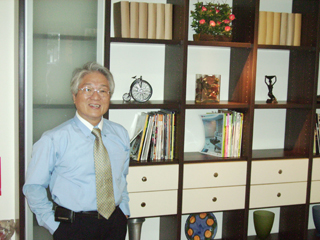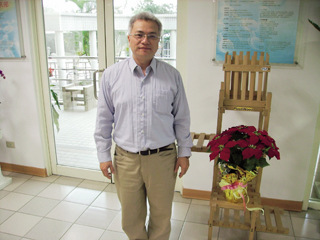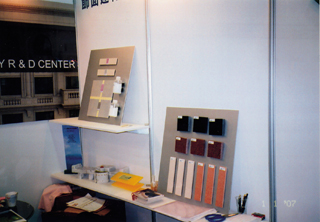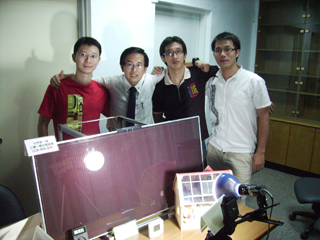TGBMC Set Up to Further Green Building Material Cause in Taiwan
2008/09/22 | By Ken LiuRecently 57 Taiwan-based building-material makers organized a trade body called Taiwan Green Building Material Council (TGBMC), marking a further step by the island's building-materials industry toward waking up people to the serious consequences of using eco-unfriendly building materials.
The Taiwan government began in 2005 to introduce an array of measures to promote the wider use of green building materials in the nation, including setting up certification systems to authenticate green materials, revising construction regulations to prompt using green materials, as well as funding R&D by academic and research institutes.

The green certification is mostly handled by the Chinese Architecture and Building Center (CABC) under the Ministry of the Interior, which marks materials with "Green Building Material Label" made by manufacturers.
Also the government amended a code stipulating that green building materials must constitute at least 5% of all those used in the total interior of a building. The new regulation came into effect on July 1, 2006 and denies any builder found in violation of a move-in permit.
The institutes funded to develop green materials include the government-backed Plastics Industry Development Center (PIDC) and Stone & Resource Industry R&D Center (SRIC) as well as the National Taiwan University of Science and Technology (NTUST).
Green Board
One such green material unveiled by the PIDC is a composite board consisting of reclaimed wood and plastics. "The board is eco-friendly since it does not use virgin materials, is durable and water resistant," says doctor Paul Chen, leader of the center's Advanced Materials Research Group.
Another green material has been launched by the SRIC: a tile coated with titanium dioxide that effectively stops bacterial growth via ridding of germ-friendly environment. "Our coating technology keeps the TiO2 film for significant periods regardless of exposure to sun, rain and wind. The best part is that the technology may be factory produced as well as DIY feasible," says doctor J.C. Kuo, Assistant Director of the center's Technical Service Department.

The NTUST recently unveiled a unique glazing featuring self-cleaning, electricity-generating, and thermal-insulation properties, which are realized by a nano coating of titanium-dioxide acting as a photocatalytic interface, and a silicon film as a solar cell and insulating film. "We developed this glass to reduce CO2 emission and fossil-fuel consumption," stresses Associate Professor Chin-huai Young at NTUST's Department of Construction Engineering. The eco-friendly glass project is financed by the Ministry of Education out of an NT$50 billion (US$1.5 billion at NT$33:US$1) fund aimed to inspire colleges to develop forward-looking technologies for local industries.
Laying Green Foundation
The above-mentioned measures have laid the basic foundation to further develop the island's green building materials sector. The green label system has certified less than 100 manufacturers, including the 57 TGBMC members, which is insignificant considering some 1,000 items as wood boards, paints and cements need to be inspected.
Initiated by Jackie Yang, honorary president of Taiwan Order Furniture Corp., the TGBMC was set up early this year by its 57 members, including Taiwan Order.
"The TGBMC aims to upgrade the degree of advancement and civilization of a society by promoting the use of building materials that help reduce energy consumption and greenhouse-gas emissions as well as enhance health," stresses Yang, TGBMC chairman.
As defined by an international academic group in 1992, Yang notes that green building materials are toxic-free and only cause minimal environmental burden in their manufacturing and recycling. "From such standard, Taiwan's building-materials industry lags far behind for it consumes huge amounts of energy, uses toxic substances, and emits enormous CO2 in manufacturing. Setting up the TGBMC aims to tell people here to minimize using eco-hazardous materials for the sake of personal well-being," he says.
Excessive Concrete Buildings
Yang's evaluation of the local building sector is underlined by a recent study released by Architecture and Building Research Institute (ABRI) of the Ministry of the Interior: Taiwan has the world's second-highest per-capita consumption of cement, mirroring the country's excessive number of concrete buildings. The study also notes that constructing a building usually consumes huge amounts of energy and resources, during occupation and later releases pollution when dismantled.
Taiwan's building industry burns a quarter of the island's energy, according to doctor W.C. Chen, a senior engineer at the Energy and Resources Laboratories (ERL) of the government-backed Industrial Technology Research Institute (ITRI) who is on the team to draft general parameters for green building materials. "Consuming such enormous energy in construction would hardly qualify Taiwan under the Kyoto Protocol in greenhouse-gas reduction," Chen notes. The use of green, recycled materials can help cut CO2 emissions by at least 80% compared with virgin materials, he says.
Yang cites his company as an example to show people how green and energy-efficient building materials can be. "We use German-made MFC or melamine faced chipboard, which is completely made of farmed, not naturally grown trees. And we've tweaked manufacturing processes to limit waste within only 5% of the output, compared with 20% at traditional manufacturers," he boasts. Yang claims his company has been awarded with the Green Building Material Label for such merits, becoming the island's only furniture manufacturer to win such honor. "Initially, CABC refused to accept our application for we're not a building-material maker. Three years of effort finally enabled us to convince them to see the boards as a building material rather than furniture. Plus they proved our products as eco-friendly and material saving," he explains.

Yang stresses green building materials also enhance health for being toxin free. "Volatile chemicals like formaldehyde are mainly the toxic substance used in typical building materials, with such toxic ingredients having been shown to be harmful to health and even carcinogenic," Yang says, citing studies by Dr. S.S. Jiang of the Shin Kong Wu Ho-su Memorial Hospital. A kidney-disease specialist, Jiang points out that volatile hydrocarbons as formaldehyde can be hazardous for as long as 10 years, during which such chemicals can cause other diseases to develop.
Cost is a Factor
However, green building materials are by no means low-priced. SRIC's Kuo estimates that green building materials are usually about 30% costlier than conventional types. "But good health is priceless. Higher health awareness has helped to raise penetration of such materials into households," Yang says, claiming his company's shipment has increased every month.
Professor Young at the NTUST is also aware of the cost factor and aims to integrate the innovative glazing with reinforced concrete to create a standard building block, reducing the price to NT$7,000 to NT$8,000 (US$212-242) from around NT$20,000 (US$606) for a one-square-meter block, claiming that the lowered price is on a par to the current price of a granite block
The TGBMC chairman believes various signs show ample room remains for Taiwan's green building materials market to grow. "First and foremost, over the past three years, less than 100 manufacturers producing some 1,000 products have been green-label approved. Plus the legislature recently revised construction codes to raise the 5% minimum to 30%, aiming to boost the use of green materials as quickly as possible," he notes.
ERL's Chen estimates that eco-friendly building materials have the potential to command around 15% or NT$30 billion (US$909 million at US$1:NT$33) of the total market in Taiwan, valued at around NT$200 billion (US$6 billion), in a few years.
Regular Promotions
To push the eco-friendliness wave, the TGBMC, Yang says, will regularly organize forums, presentations and trade shows to promote such materials. "Meanwhile, the Council will encourage its members to keep developing new products, not merely for profit, but to enhance consumer welfare," Yang says.
The TGBMC will invite more green-labeled manufacturers to become members and recruit retired government officials and scholars as consultants. "Also, we welcome interested teachers and students to become members," Yang says, justifying the trade group's approach to expand size and influence.

Yang urges Taiwan to emulate Germany to promote green materials, noting that Germany does not regulate homebuilders but material makers to comply with eco-friendly standards. "Thus, all German suppliers are green qualified and so are all buildings," he says.
Germany and Japan, Yang says, boast the world's most advanced green building material technologies due to, surprisingly, being losers in World War II. "The two countries were badly defeated in the war and their scientists realized that construction materials for post-war reconstruction would run short. So, recycling was an idea that proved again "necessity is the mother of invention." The Japanese and Germans therefore scavenged post-war ruins for building materials.
"Importing MFC boards from Germany some 10 years ago sparked eco-awareness in my company, a sentiment that I'm confident will filter down to most consumers here. After all, demand is a powerful force of attrition as over the past few years I've seen many disqualified manufacturers shutter their operations to move offshore," he concludes.




